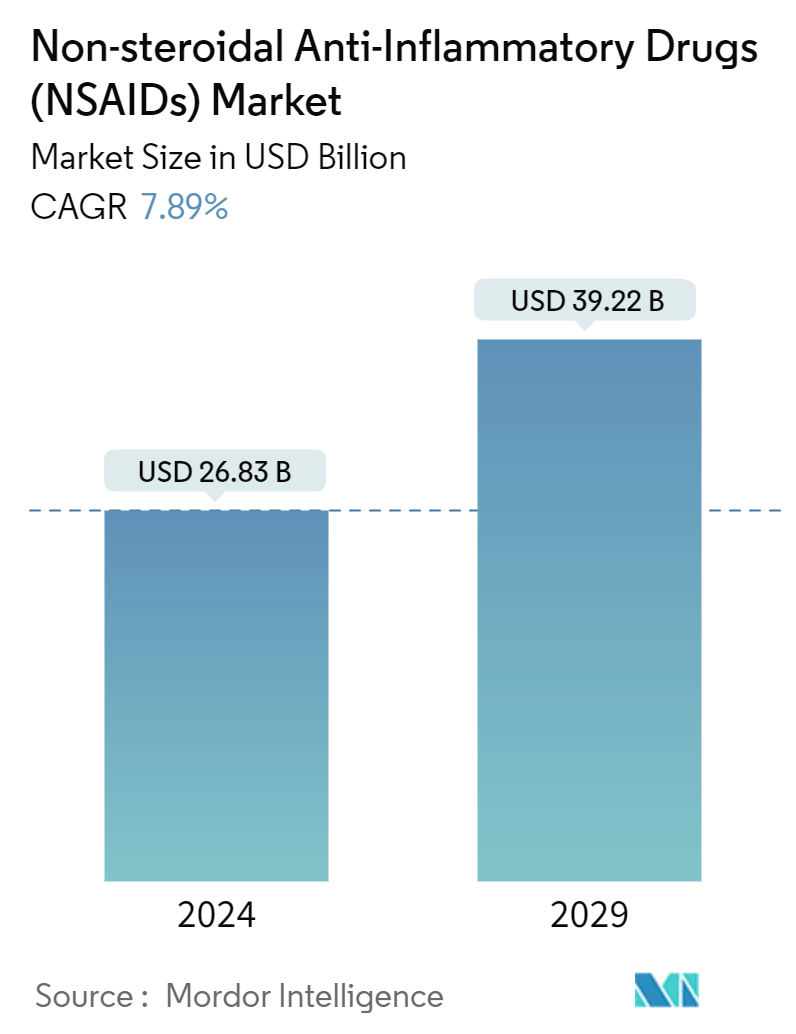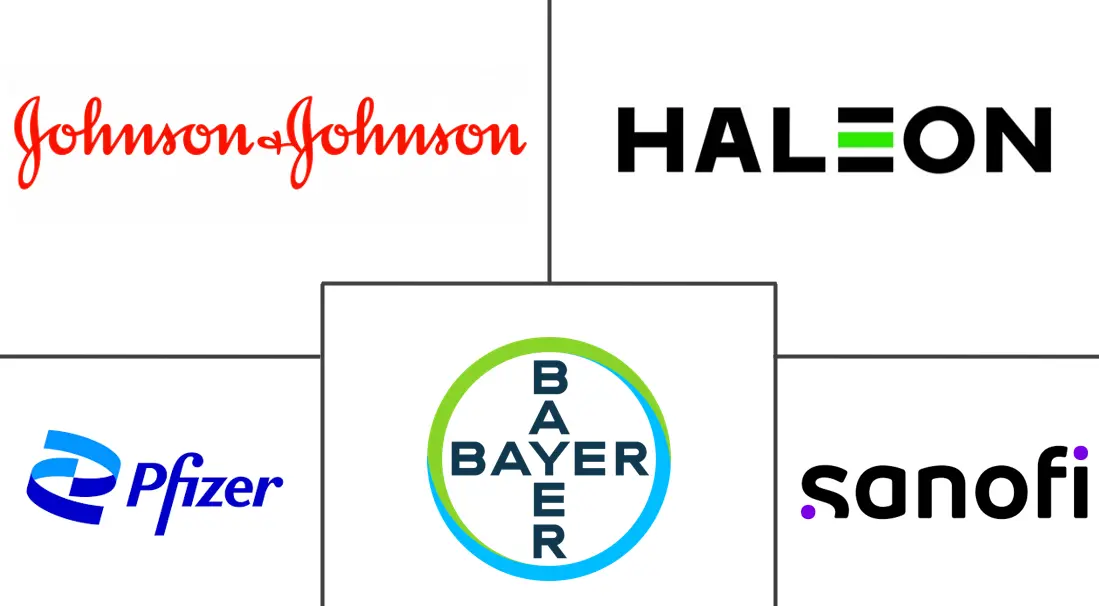Market Size of Non-steroidal Anti-Inflammatory Drugs (NSAIDs) Industry

| Study Period | 2019 - 2029 |
| Market Size (2024) | USD 26.83 Billion |
| Market Size (2029) | USD 39.22 Billion |
| CAGR (2024 - 2029) | 7.89 % |
| Fastest Growing Market | Asia-Pacific |
| Largest Market | North America |
| Market Concentration | Low |
Major Players
*Disclaimer: Major Players sorted in no particular order |
Non-steroidal Anti-inflammatory Drugs Market Analysis
The Non-steroidal Anti-Inflammatory Drugs Market size is estimated at USD 26.83 billion in 2024, and is expected to reach USD 39.22 billion by 2029, growing at a CAGR of 7.89% during the forecast period (2024-2029).
The increasing burden of chronic pain and inflammatory diseases globally is expected to boost the market's growth during the forecast period, as NSAIDs are widely used in their treatment and management. In addition, investment in research and development by pharmaceutical companies to develop advanced NSAIDs is likely to contribute to market expansion.
The high prevalence of low back pain, which is expected to increase in the coming years, is anticipated to lead to a rise in the usage of NSAIDs during the forecast period. For instance, according to data published by the WHO in December 2023, projections estimate that 843 million individuals will experience low back pain by 2050, with the most significant increases expected in Africa and Asia due to their expanding populations and increasing life expectancies. This high number of low back pain cases increases the usage of NSAIDs and is expected to contribute to the growth of the market during the forecast period.
Musculoskeletal conditions such as arthritis and back pain are some of the leading contributors to disability worldwide. For instance, according to data published by the National Center for Health Statistics in February 2024, the age-adjusted prevalence of arthritis in adults aged 18 and older in the United States was reported to be 18.9% in 2022, which is significantly high. Therefore, the high burden of musculoskeletal disorders is likely to lead to a growing demand for pain management drugs such as NSAIDs, contributing to the market's growth during the forecast period.
Also, the growing awareness among the public through awareness initiatives likely increases the usage of aspirin as it is widely used in cardiovascular diseases. For instance, in February 2023, Huma Therapeutics Limited and Bayer entered a partnership to develop the Bayer aspirin heart risk assessment online tool to raise awareness of heart health and its risk factors. Hence, understanding heart health and its risk factors helps increase aspirin usage in ongoing health management. Thus, this growing awareness is expected to drive market growth due to the proper usage of NSAIDs by the public.
Therefore, the high burden of pain cases due to musculoskeletal conditions and increasing awareness are likely to drive market growth during the forecast period. However, the side effects caused by the use of NSAIDs are expected to restrain the market's growth during the forecast period.
Non-steroidal Anti-inflammatory Drugs Industry Segmentation
As per the report's scope, non-steroidal anti-inflammatory drugs (NSAIDs) are medications that reduce pain, decrease fever, prevent blood clots, and decrease inflammation in higher doses. NSAIDs inhibit enzymes in the body that produce prostaglandins, which are naturally occurring fatty acids that contribute to pain and inflammation.
The non-steroidal anti-inflammatory drugs (NSAIDs) market is segmented by route of administration, application, distribution channel, and geography. By route of administration, the market is segmented into oral, parenteral, topical, and other routes of administration. By application, the market is segmented into arthritis, migraine, ophthalmic diseases, and other applications. The other applications include fever and blood clots. By distribution channel, the market is segmented into hospital pharmacies, retail pharmacies, and other distribution channels. By geography, the market is segmented into North America, Europe, Asia-Pacific, the Middle East and Africa, and South America. The report also covers the estimated market sizes and trends for 17 countries across major regions globally. The report offers the market size and forecasts in value (USD) for the above segments.
| By Route of Administration | |
| Oral | |
| Parenteral | |
| Topical | |
| Other Routes of Administration (Rectal, Nasal, etc.) |
| By Application | |
| Arthritis | |
| Migraine | |
| Ophthalmic Diseases | |
| Other Applications (Fever, Dysmenorrhea, etc.) |
| By Distribution Channel | |
| Hospital Pharmacies | |
| Retail Pharmacies | |
| Others Distribution Channels (Wholesale Pharmacies, Supermarkets, etc.) |
| Geography | ||||||||
| ||||||||
| ||||||||
| ||||||||
| ||||||||
|
Non-steroidal Anti-Inflammatory Drugs (NSAIDs) Market Size Summary
The non-steroidal anti-inflammatory drugs (NSAIDs) market is poised for significant growth, driven by the increasing global prevalence of chronic pain and inflammatory diseases. The demand for NSAIDs surged during the COVID-19 pandemic as they were utilized to alleviate symptoms such as pain, fever, and inflammation associated with the virus. This heightened demand is expected to persist due to the ongoing emergence of mutant strains of the virus. Additionally, the widespread use of NSAIDs in managing musculoskeletal disorders and migraines, which are prevalent worldwide, is anticipated to further propel market expansion. However, the market's growth may be tempered by the side effects associated with NSAID use.
The arthritis segment is projected to dominate the NSAIDs market, fueled by the rising incidence of arthritis globally and the need for effective pain management solutions. The aging population's increased susceptibility to arthritis, coupled with the high prevalence of musculoskeletal disorders, is expected to drive demand for NSAIDs. North America is anticipated to lead the market, supported by a significant demand for pain relief drugs and a strong focus on developing novel NSAID formulations with reduced side effects. The competitive landscape of the NSAIDs market is moderately concentrated, with major players like Pfizer Inc., Johnson & Johnson, and Bayer AG leading the charge, while ongoing research and development efforts are likely to introduce new entrants and innovations in the market.
Non-steroidal Anti-Inflammatory Drugs (NSAIDs) Market Size - Table of Contents
-
1. MARKET DYNAMICS
-
1.1 Market Overview
-
1.2 Market Drivers
-
1.2.1 Increasing Burden of Chronic Pain and Inflammation
-
1.2.2 Preference of NSAIDs Over Other Class of Pain Relievers
-
-
1.3 Market Restraints
-
1.3.1 High Cost of Drug Development and Launches
-
1.3.2 Side Effects of NSAIDs
-
-
1.4 Porter's Five Forces Analysis
-
1.4.1 Threat of New Entrants
-
1.4.2 Bargaining Power of Buyers/Consumers
-
1.4.3 Bargaining Power of Suppliers
-
1.4.4 Threat of Substitute Products
-
1.4.5 Intensity of Competitive Rivalry
-
-
-
2. MARKET SEGMENTATION (Market Size by Value - USD)
-
2.1 By Route of Administration
-
2.1.1 Oral
-
2.1.2 Parenteral
-
2.1.3 Topical
-
2.1.4 Other Routes of Administration (Rectal, Nasal, etc.)
-
-
2.2 By Application
-
2.2.1 Arthritis
-
2.2.2 Migraine
-
2.2.3 Ophthalmic Diseases
-
2.2.4 Other Applications (Fever, Dysmenorrhea, etc.)
-
-
2.3 By Distribution Channel
-
2.3.1 Hospital Pharmacies
-
2.3.2 Retail Pharmacies
-
2.3.3 Others Distribution Channels (Wholesale Pharmacies, Supermarkets, etc.)
-
-
2.4 Geography
-
2.4.1 North America
-
2.4.1.1 United States
-
2.4.1.2 Canada
-
2.4.1.3 Mexico
-
-
2.4.2 Europe
-
2.4.2.1 Germany
-
2.4.2.2 United Kingdom
-
2.4.2.3 France
-
2.4.2.4 Italy
-
2.4.2.5 Spain
-
2.4.2.6 Rest of Europe
-
-
2.4.3 Asia-Pacific
-
2.4.3.1 China
-
2.4.3.2 Japan
-
2.4.3.3 India
-
2.4.3.4 Australia
-
2.4.3.5 South Korea
-
2.4.3.6 Rest of Asia-Pacific
-
-
2.4.4 Middle East and Africa
-
2.4.4.1 GCC
-
2.4.4.2 South Africa
-
2.4.4.3 Rest of Middle East and Africa
-
-
2.4.5 South America
-
2.4.5.1 Brazil
-
2.4.5.2 Argentina
-
2.4.5.3 Rest of South America
-
-
-
Non-steroidal Anti-Inflammatory Drugs (NSAIDs) Market Size FAQs
How big is the Non-steroidal Anti-Inflammatory Drugs Market?
The Non-steroidal Anti-Inflammatory Drugs Market size is expected to reach USD 26.83 billion in 2024 and grow at a CAGR of 7.89% to reach USD 39.22 billion by 2029.
What is the current Non-steroidal Anti-Inflammatory Drugs Market size?
In 2024, the Non-steroidal Anti-Inflammatory Drugs Market size is expected to reach USD 26.83 billion.

